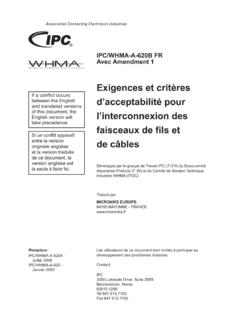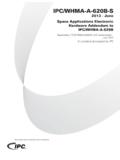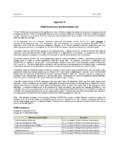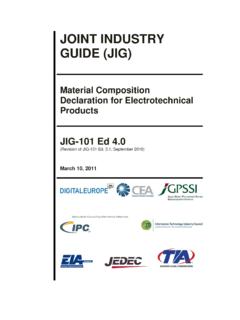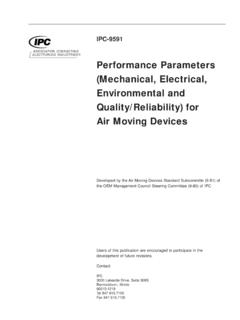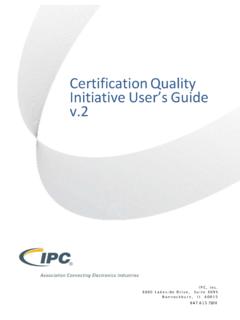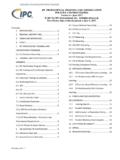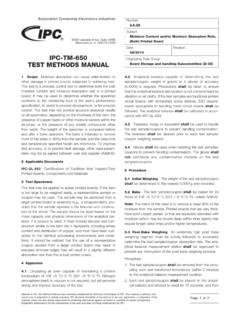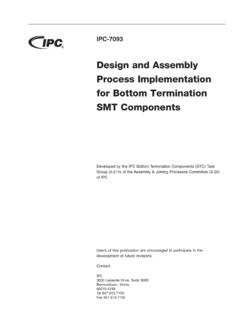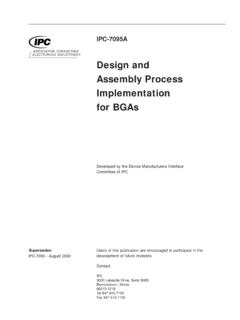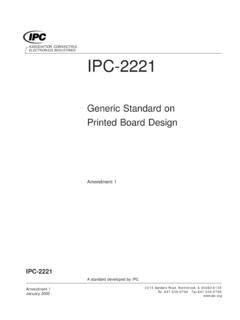Transcription of A standard developed by IPC
1 IPC/JEDEC-9702 Amendment 12015 - MayMonotonic Bend Characterizationof Board-Level InterconnectsA standard developed by IPC Association Connecting Electronics IndustriesThe Principles ofStandardizationIn May 1995 the IPC s Technical Activities Executive Committee (TAEC) adopted Principles ofStandardization as a guiding principle of IPC s standardization : Show relationship to Design for Manufacturability(DFM) and Design for the Environment (DFE) Minimize time to market Contain simple (simplified) language Just include spec information Focus on end product performance Include a feedback system on use andproblems for future improvementStandardsShouldNot: Inhibit innovation Increase time-to-market Keep people out Increase cycle time Tell you how to make something Contain anything that cannotbe defended with dataNoticeIPC standards and Publications are designed to serve the public interest through eliminating mis-understandings between manufacturers and purchasers, facilitating interchangeability and improve-ment of products, and assisting the purchaser in selecting and obtaining with minimum delay theproper product for his particular need.
2 Existence of such standards and Publications shall not inany respect preclude any member or nonmember of IPC from manufacturing or selling productsnot conforming to such standards and Publication, nor shall the existence of such standards andPublications preclude their voluntary use by those other than IPC members, whether the standardis to be used either domestically or standards and Publications are adopted by IPC without regard to whether their adop-tion may involve patents on articles, materials, or processes. By such action, IPC does not assumeany liability to any patent owner, nor do they assume any obligation whatever to parties adoptingthe Recommended standard or Publication. Users are also wholly responsible for protecting them-selves against all claims of liabilities for patent PositionStatement onSpecificationRevision ChangeIt is the position of IPC s Technical Activities Executive Committee that the use and implementationof IPC publications is voluntary and is part of a relationship entered into by customer and an IPC publication is updated and a new revision is published, it is the opinion of the TAEC that the use of the new revision as part of an existing relationship is not automatic unless requiredby the contract.
3 The TAEC recommends the use of the latest October 6, 1998 Why is therea charge forthis document?Your purchase of this document contributes to the ongoing development of new and updated industrystandards and publications. standards allow manufacturers, customers, and suppliers to understandone another better. standards allow manufacturers greater efficiencies when they can set up theirprocesses to meet industry standards , allowing them to offer their customers lower spends hundreds of thousands of dollars annually to support IPC s volunteers in the standardsand publications development process. There are many rounds of drafts sent out for review andthe committees spend hundreds of hours in review and development. IPC s staff attends and par-ticipates in committee activities, typesets and circulates document drafts, and follows all necessaryprocedures to qualify for ANSI s membership dues have been kept low to allow as many companies as possible to , the standards and publications revenue is necessary to complement dues revenue.
4 Theprice schedule offers a 50% discount to IPC members. If your company buys IPC standards andpublications, why not take advantage of this and the many other benefits of IPC membership aswell? For more information on membership in IPC, please visit or call 847 you for your continued support. Copyright 2015. IPC, Bannockburn, Illinois, USA, and JEDEC Solid State Technology Association, Arlington, Virginia. All rights reserved underboth international and Pan-American copyright copying, scanning or other reproduction of these materials without the priorwritten consent of the copyright holder is strictly prohibited and constitutes infringement under the Copyright Law of the United Bend Characterization ofBoard-Level InterconnectsFOREWORDThis amendment provides a clerical correction to ,Test Board Daisy-Chain Links, which better expressesthe intent of the IPC and JEDEC committees to recom-mend avoiding stress artifacts and to offer strategies to Text Board Daisy-Chain Links4th Paragraph, replace first sentence as follows:Electrical monitoring traces should be routed so as to avoidthe propensity for artifacts of the stress (trace/via cracks).
5 Some strategies may include routing to the long side of thePCB whereby the traces are 45 - 90 from the bend direc-tion or routing on internal PWB layers to reduce the like-lihood of external trace contact damage during 2015 IPC/JEDEC-9702 - Amendment 11
